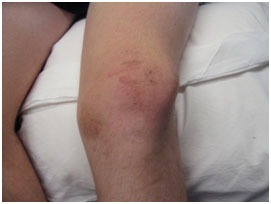What is Patella Dislocation?
The patella is normally placed in the groove between the condyles of the femur. Patellar dislocation refers to the completely displaced of the patella out of its normal alignment. The patella normally dislocates laterally (outwards), disrupting (damaging) the medial (inner) ligaments and muscles attached to it.
Patella subluxation refers to partially displaced out of its normal position, overstretching the medial structures attached to it.
Mechanism of Injury:
Patellar dislocation is most common in athletes while pivoting. In a pivoting movement, the femur (thigh bone) internally rotated on a planted foot, with this if the athlete does bending of the knee is the most likely move to cause the dislocation.

Laterally displaced patella (dislocated)
Causes of Patella Dislocation?
Patellar dislocation is primarily a result of a traumatic incident (often twisting or a direct blow) to the knee. The factors that may predispose to patellar dislocation include:
- History of patella dislocation or subluxation,
- Hyperlaxity or mal tracking of the patellofemoral joint,
- Shallow femoral groove,
- Weak inner quadriceps muscles and
- Tight lateral structures like lateral retinaculum, IT band, TFL, hip extensors, and lateral rotators.
Symptoms of Patella Dislocation?
- Patients complaints of patellar slipping out of place which may self relocate,
- Visible translation of patella laterally out of the grove,
- Pain with activities that give the sense of dislocation, Swelling, and a wobbly kneecap.
- Tenderness around the patella.
- Feeling of instability or giving way during weight-bearing.
- Weakness of the quadriceps muscles.
Diagnosis
A patellar dislocation can be easily diagnosed as the patient presents with dislocated patella or it can be easily subluxated/ dislocated with trivial force applied by the best physiotherapist. The therapist can look for associated signs and symptoms of patellar dislocation.
An x-ray will show the displaced patella. An MRI may be needed to identify damage to structures surrounding the patella or to the patellar joint surface, which is quite common.
Treatment of Patella Dislocation
- Patella Relocation
The relocation part should be always done by an expert sports physician or Orthopaedician if it did not occur spontaneously.
- Physiotherapy treatment
Most patients with patella dislocation start to feel better within a few hours of the relocation. However, the rehabilitation treatment will take at least six weeks to prevent recurrent dislocation. The majority of patients with patella dislocation respond well with conservative treatment.
The physiotherapy treatment aims at:
- Reducing pain and swelling.
- Protect the patella via taping or a patella alignment brace, e.g. patella brace
- Normalize joint range of motion,
- Strengthening the knee muscles especially the VMO part of quadriceps,
- Strengthening the lower limb muscles,
- Improving patellofemoral alignment.
- Normalize the muscle and retinaculum lengths.
- Improve proprioception and balance.
- Improve overall knee functionality with activities like walking, running, squatting and jumping,
- Minimize the chances of re-dislocation.
- Surgery
Surgery may be required if significant ligament or other structural damage has occurred as a result of dislocation. This may include injury to the medial patella ligaments and muscles, kneecap surface. Surgically these structures are repaired or even at times lateral patellofemoral ligament is released.
Post-Surgical Rehabilitation:
Post-operative rehabilitation is one of the most important, yet too often neglected, aspects of relocation surgery. One must undergo physiotherapy rehabilitation post-surgery for a quicker and better outcome.
Post-surgery rehab focuses on restoring full knee motion, strength, power and endurance, balance and proprioception, and agility training which should be individualized to one’s specific sporting or functional needs.
Prevention:
With patellar dislocation, the chances of reoccurrence are 50% if the patient doesn’t undergo physiotherapy rehabilitation. The risk of re-injury increases substantially each time the patella is dislocated.





